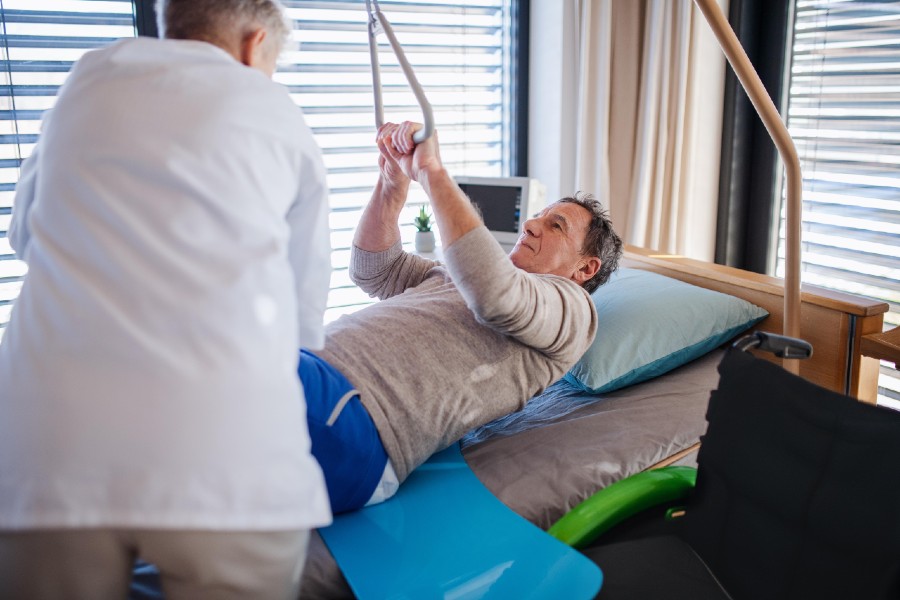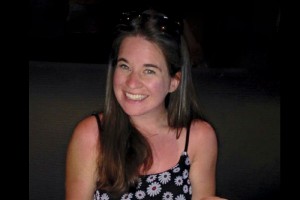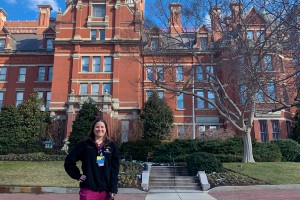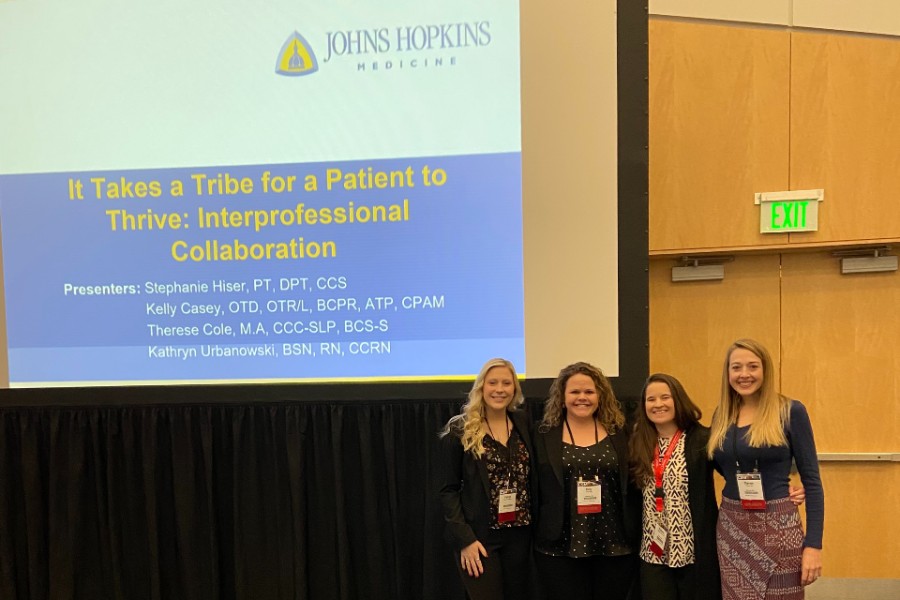Exercise science alumna studies at Johns Hopkins to become a clinical investigator
Stephanie Hiser is taking her quest to improve patient rehab to new heights with NIH-funded Ph.D.
Janel Shoun-Smith | 615.966.7078 |

Stephanie Hiser ('12) is earning a doctorate in Johns Hopkins to become a go-to NIH researcher in the physical rehabilitation of hospitalized patients, as shown here, specifically patients in the intensive care unit setting.
When it comes to resilience, persistence and optimism, Dr. Stephanie Hiser (’12), a physical therapist most recently at Johns Hopkins Hospital, is an expert, and that’s a good thing for her patients, who find themselves having to fight back to health after an acute-care hospital stay.
“I try to instill in my patients the idea that each day is a different day, and even though you weren’t able to stand or take those first steps today, doesn’t mean it won’t happen tomorrow or the next day,” said Hiser, who came by her resilience through personal family struggles and many long years building her career in physical therapy, and as a future independent clinical investigator, at one of the nation’s top hospitals.
“I think in academics, research and life in general, having a mind-set that allows you to bounce back from repeated failures, learn from them and keep moving forward is critical,” she said.
Hiser has been moving forward ever since she left her family home in Glasgow, Kentucky, to come to Lipscomb University and pursue health sciences.
While at Lipscomb, she determined that physical therapy was the right health profession for her, and just two weeks after walking the stage in Allen Arena to get her exercise science degree, she was off to start the Doctorate of Physical Therapy program at the University of Miami, a program that had a research-focused faculty with an emphasis in rehabbing patients with neurological disorders.
After earning that degree, she applied, and was accepted, for a physical therapy residency spot in at Johns Hopkins Hospital, ranked the third best hospital in the nation by U.S. News and World Report.
After her residency, she continued to work at Johns Hopkins in a critical care fellowship for physical therapists and then entered the Johns Hopkins School of Public Health to earn a Ph.D. in clinical investigation.
Upon completion of her Ph.D., she will have the credentials, experience and the skills needed to be a go-to scientist for clinical studies in early rehabilitation in patients who are critically ill as well as studies funded by the National Institutes of Health, the largest biomedical research agency in the world.

Stephanie Hiser
Over the course of her career, Dr. Hiser’s focus has become the physical rehabilitation of hospitalized patients, specifically patients in the intensive care unit setting. These treatments have gained greater awareness over the past five years and especially since the Covid-19 pandemic has resulted in thousands of patients emerging from time spent on a ventilator or other life-saving equipment, she said.
“You need an interprofessional approach to get the patients back to their former quality of life,” said Hiser. “Being in a hospital bed can cause a lot of cognitive and psychological impact in addition to the physical impairments.”
Patients she treats have often suffered from heart attacks, acute respiratory distress syndrome, various surgeries, liver failure, kidney failure, and sometimes a combination of many such diagnoses, she said. “In the end, what the patient wants is to go back to the activities they love. Sometimes you have to remind them: that is the goal.”
After neurological and cardiopulmonary courses in her UM studies, Hiser launched into her second clinical rotation and found that she was constantly using her knowledge from courses to consider how early rehabilitation could be done better for the recovery of the acute care hospital patients. She and a classmate found some literature on early rehab for ICU patients and were successful in getting the pulmonary critical care director at that hospital thinking about how rehabilitation could be done better at that facility, she said.
“(At the time of my rotations) many staff members weren’t familiar with the literature on rehab being safe and feasible in the ICU setting, especially those requiring mechanical ventilation. Because of that there were a lot of other clinical barriers to providing rehab. You have to have buy-in from other providers, because it is an interdisciplinary approach.”

Stephanie Hiser is now earning a Ph.D. at Johns Hopkins, pictured here.
For example, if a patient is too heavily sedated, they aren’t able to participate to an effective degree, she explained.
“In the past five years, we have started seeing more movement in the direction (of collaboration toward early rehab). It takes people who are passionate about it, to go seek out that solution,” Hiser said.
That innovative spirit continued in her future placements. Now focused on cardiovascular and pulmonary care, she researched physical therapy residency programs—which weren’t plentiful at the time—and found one acute care physical therapy residency: at Johns Hopkins, which is on the forefront of early rehab research, Hiser said. In August of 2015, she moved to Baltimore.
“I had the opportunity to clinically work with various populations—medical, surgical, neuro, oncology—and with mentors who were senior, board certified physical therapists who had worked in their profession for a very long time,” she said of the one-year program.
Next she applied for a fellowship at Johns Hopkins, which allowed her to continue working and researching with Dr. Dale Needham, a Hopkins medical doctor who has been leading the way in research on early rehab for critical care patients for a decade.
Eventually she became full-time staff at Hopkins, and Needham suggested to her that she consider Hopkins’ Ph.D. in clinical investigation as a way to continue her clinical research and become an independent researcher in the future. She was accepted to the Bloomberg School of Public Health in 2019, and is now working on her research project to better define physical therapist’s rehabilitation prescription for ICU patients.

Hiser's Ph.D. will make her a go-to researcher for the NIH.
Hiser’s Ph.D. studies are funded through an NIH pipeline grant designed to encourage professionals to become clinical researchers. The Hopkins clinical investigation program teaches how to design studies, how to analyze data and other investigative skills that clinical researchers need to run their own clinical projects and to land national grants—including NIH grants—to fund them.
“The more training you have in preparing NIH-level clinical studies, hopefully the more grants you will be awarded throughout your career,” Hiser explained.
In her Ph.D. research, she finds herself “circling back to my bachelor’s degree in exercise science to think about how we improve rehab prescription by being more individualized to the patients,” she said. These days she is exploring how to apply the precision medicine approach from a rehabilitation perspective, which has her “looking at the exercise parameters that I learned back in my bachelor’s degree.”
“Many of the classes at Lipscomb forced me to think outside the box,” said Hiser. “Dr. (Phil) Choate’s anatomy course was one of my favorite courses and it was harder than my anatomy course in physical therapy school. The labs for that class forced you to think critically about the entire picture, the entire patient and the patient’s story.”
During her undergraduate years, she was a resident assistant in Johnson Hall, a member of the Gamma Lambda social club and participated in a mission trip to Ghana in 2010.
In addition, she threw herself into volunteering at local hospitals, including Vanderbilt Stallworth Rehabilitation Hospital, where she witnessed many patients with a variety of neurological issues demonstrating those characteristics she so values: resiliency, persistence and optimism.
“I finally realized that I enjoyed the advantage that many physical therapists had of being able to spend more time with patients and seeing the impact of the interventions over time,” she said.
In addition to becoming a successful NIH-funded independent clinical investigator who advances the field of early rehabilitation, Hiser said also hopes that someday in her career she can “mentor students the way I was mentored to get where I am today.”
“These goals are important to me because I want to have an impact on the greatest number of patients possible even if I’m not the one providing the interventions, which I feel is the opportunity that clinical research provides.”